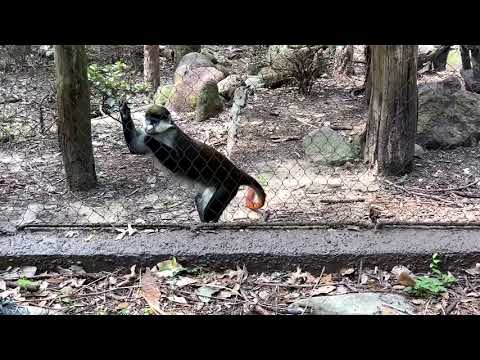– Characteristics and behaviors of March 27 – Schmidt’s Red-Tail Monkeys
– Their natural habitat and distribution
– Threats facing these primates and conservation efforts
– The role of zoos in the conservation and education about Schmidt’s Red-Tail Monkeys
– Importance of video documentation in understanding and preserving wildlife
**Characteristics and Behaviors of March 27 – Schmidt’s Red-Tail Monkeys**
March 27 – Schmidt’s Red-Tail Monkeys, scientifically known as Cercopithecus ascanius, are a captivating species native to the forests of central Africa. These primates are known for their striking appearance, featuring a reddish tail, contrasting beautifully with their grey to deep brown bodies. An intriguing aspect of these monkeys is their complex social structure, typically living in troops of 15 to 30 individuals. These groups are matriarchal, with females usually staying within their birth groups for life, while males tend to migrate to new groups upon reaching sexual maturity. They exhibit a remarkable range of vocalizations and facial expressions, crucial for communication within the dense forests they inhabit. These social and communicative behaviors are not just fascinating; they are vital for survival, aiding in everything from locating food to evading predators.
**Their Natural Habitat and Distribution**
Schmidt’s Red-Tail Monkeys’ natural habitat spans central Africa’s dense, tropical rainforests. Notably, their presence is significant in countries such as the Democratic Republic of Congo, Uganda, and Tanzania. These primates strongly prefer primary and secondary forests, thriving in rich, diverse environments that provide ample food and shelter. The geographical distribution of this species emphasizes the critical importance of forest ecosystems not only for Schmidt’s Red-Tail Monkeys but also for countless other species that share these habitats.
**Threats Facing These Primates and Conservation Efforts**
Despite their adaptability, Schmidt’s Red-Tail Monkeys face significant threats, primarily habitat destruction and fragmentation due to logging, agricultural expansion, and human settlement. Illegal hunting for bushmeat poses another grave threat, further exacerbated by the lack of enforcement of wildlife protection laws. Conservation efforts for these monkeys are multifaceted, involving habitat preservation, anti-poaching measures, and local community engagement to promote sustainable coexistence. International cooperation is also crucial, with several organizations working towards establishing protected areas and implementing conservation action plans to secure a future for these primates.
**The Role of Zoos in the Conservation and Education of Schmidt’s Red-Tail Monkeys**
Zoos play an increasingly pivotal role in conserving Schmidt’s Red-Tail Monkeys. These institutions are not only involved in captive breeding programs aimed at preserving genetic diversity but also engage in research that can provide valuable insights into these animals’ health, behavior, and reproduction. Moreover, zoos serve as powerful platforms for educating the public about the plight of Schmidt’s Red-Tail Monkeys and the broader issues of wildlife conservation. Through educational programs and interactive exhibits, zoos raise awareness and foster a sense of stewardship among visitors, encouraging actions that support the preservation of these primates and their habitats.
**Importance of Video Documentation in Understanding and Preserving Wildlife**
Video documentation is critical in studying and conservating species like Schmidt’s Red-Tail Monkeys. High-quality videos can capture the nuances of primate behavior, social interactions, and habitat use in ways that are impossible through observation alone. These visual records provide researchers and conservationists with invaluable data, contributing to our understanding of these animals and informing conservation strategies. Additionally, sharing these videos with the public can play a significant role in conservation efforts, illustrating both the beauty of these creatures and the challenges they face, thereby inspiring action and support for their preservation.
In essence, the study and conservation of Schmidt’s Red-Tail Monkeys require a comprehensive approach, encompassing habitat protection, research, public education, and international cooperation. By fostering a deeper understanding and appreciation of these primates and their ecosystems, we can work towards securing their future, ensuring that March 27 – Schmidt’s Red-Tail Monkeys continue to thrive in the wild for generations to come.
*****
Source Description
Stop by Wortham World of Primates to see our Schmidt’s red-tailed monkeys! You can spot our family group, including Mom and Dad, Njeri and Kibali, along with three-year-old Peter Rabbit. This monkey species is very social and lives in groups of one male and multiple females, with some groups being as large as 25 monkeys in the wild.


